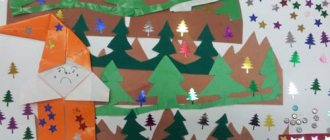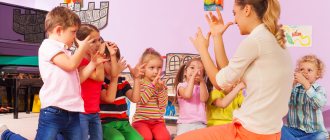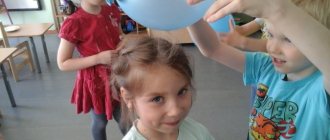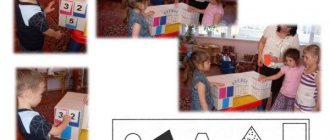Project activities in preschool educational institutions: approaches, content
Currently, in preschool education, traditional education is being replaced by developmental education, which is aimed at developing creative abilities , developing cognitive interest and the need for active creative activity in preschoolers. The project method fully complies with the requirements of the Federal State Educational Standard for preschool education and can be implemented both within the framework of the cognitive development of preschool children and through the integration of educational areas .
The project method as a set of educational and cognitive techniques that make it possible to solve a particular problem as a result of independent actions of students with the obligatory presentation of these results.
The goal is to develop the creative abilities of the child’s personality, which are determined by the developmental tasks and tasks of the children’s research activities.
Objectives : - teach basic planning; — develop skills in collecting and processing information and materials; — develop creative abilities; - to form a positive attitude towards cognitive, research, creative activities.
Basic requirements for project activities: - the presence of a problem that requires integrated knowledge and a research search for its solution; — practical, theoretical, cognitive significance of the expected results; - independent activity of a preschooler; - use of research methods, i.e. defining the problem, the research tasks arising from it, putting forward a hypothesis for their solution. Discussion of research methods, presentation of final results, analysis of the data obtained, summing up, adjustments, conclusions.
Typology of projects : (according to E. S. Evdokimova “Design technology in preschool educational institutions”) - the dominant activity in the project: research, search, creative, role-playing, applied (practice-oriented), orientation, etc. (research project, game, practice-oriented, creative); — subject-content area : mono project (within one area of knowledge), interdisciplinary project; — the nature of project coordination (leadership from the teacher): direct (rigid, flexible), hidden (implicit, simulating a project participant, typical for telecommunications projects); — number of project participants (individual, pair, group); — duration of the project (short-term (1-2 lessons), medium-term (up to a month), long-term.
A feature of project activities in the preschool education system is that the child cannot yet independently find contradictions in the environment, formulate a problem, or determine a goal (intention). Therefore, in the educational process of a preschool educational institution, project activities are in the nature of cooperation, in which children and teachers of the preschool educational institution take part, and parents and other family members are also involved. Parents can not only be sources of information, real help and support for the child and teacher in the process of working on the project, but also become direct participants in the educational process. In this way, parents can enrich their teaching experience, experience a sense of ownership and satisfaction from their successes and the successes of their child [1]
The specificity of using the project method in preschool practice is that adults need to “guide” the child, help detect a problem or even provoke its occurrence, arouse interest in it and “draw” children into a joint project, without overdoing it with parental care and help. Project activities in kindergarten can be represented as a way of organizing the pedagogical process, based on the interaction between teacher and student, a way of interaction with the environment, step-by-step practical activities to achieve the goal [1].
In a preschool institution there may be [2]: 1. Information projects - aimed at collecting information about some object, familiarizing project participants with this information, analyzing it and summarizing facts intended for a wide audience; — structure of the information project: receiving and processing information, obtaining results, presentation.
An example of an information project can be viewed here.
2. Research projects - a research search is carried out, the results of which are presented in the form of some kind of creative product (newspapers, dramatizations, card indexes of experiences, children's design, cookbook, etc.)
An example of a research project can be viewed here.
3. Role-playing projects are projects with elements of creative games, when children take on the role of fairy tale characters and solve the problems in their own way. 4. Creative projects - as a rule, do not have a detailed structure of joint activities of participants; — creative projects are classified according to the dominant type of creativity: artistic and visual, artistic and speech, artistic and design, theatrical, musical, etc.)
An example of a creative project can be viewed here.
Activities of the teacher : At stage 1 - determines the topic, carries out planning, organizes a subject-development environment, informs parents, studies literature. In the process of joint activities with students, he formulates a problem, helps set a goal, and offers to immediately determine the product of the project; immerses you in a game (plot) problem situation. At stage 2 - helps to divide into groups; helps in solving problems; helps plan activities (where to start). Organizes search and research activities of children. At stage 3 - provides practical assistance to children, creates conditions and motivates children. Monitors and coordinates the project. Records the results of information searches, etc. At stage 4 - preparation for the presentation. Presentation (project defense), evaluation.
Activities of preschoolers : At stage 1 - entering into the problem, “getting used to” the game situation, accepting the task, suggestions and additions to the final product. At stage 2 , children are organized into working groups, assigned directions for collecting material and areas of responsibility. At stage 3 - accumulation, systematization and assimilation of new knowledge, skills, abilities. At stage 4 - preparation for project defense, production of the final product. Presenting the products of your activities to the audience
Structure of the educational project: - name of the project; — authors, coordinators, administrators, project organizers; — general characteristics of the project: project participants, project deadlines, project goals and objectives, project hypothesis, expected results; — stages of the project; — project results, their evaluation, prizes and awards.
Sample topics:
- complex:
“World of Theater”, “Hello, Pushkin!”, “Echo of Centuries”, “Book Week”; - intergroup:
“Mathematical collages”, “The world of animals and birds”, “Seasons”; - creative:
“My friends”, “In our boring garden”, “We love fairy tales”, “The world of nature”, “Rowan berries of Russia”; - group:
“Tales of Love”, “Know Yourself”, “Underwater World”, “Fun Astronomy”; - individual:
“Me and my family”, “Family tree”, “Secrets of grandma’s chest”, “Fairytale bird”; - research:
“The World of Water”, “Breath and Health”, “Nutrition and Health”.
In terms of duration, they can be short-term (one or several lessons), medium-long, long-term (for example, “Pushkin’s Work” - for the academic year).
Approximate scheme for the implementation of the “Family” project (old age)
Sources:
- Kovylyaeva L. A., Tretyakova N. I. Using technology of project activities in teaching preschoolers // Scientific and methodological electronic journal “Concept”. – 2016. – T. 46. – P. 167–175. – URL: https://e-koncept.ru/2016/76508.htm.
- Project activities in preschool educational institutions
- https://doshvozrast.ru/metodich/konsultac04.htm
Colleagues!
Let's think about it...
What place does project activity occupy in preschool education?
The project method in preschool education, as one of the methods of integrated teaching of preschoolers
Relevance . Today, in connection with the introduction of State requirements for the development of children of early and preschool age in the Republic of Uzbekistan, there is a need to update and improve the quality of preschool education. Preschool educational organizations of Uzbekistan implement the State curriculum for preschool education “Ilk Kadam”, which is aimed at identifying and developing creative and cognitive abilities, taking into account the age characteristics of children.
One of the most striking, educational, interesting, and significant methods for both adults and preschool children is project activity. This is due to the fact that design in all spheres of human activity is becoming a universal tool that allows it to be systematic, goal-oriented and effective.
The project method occupies a leading place among innovative methods found in the arsenal of world and domestic pedagogical practice.
Target . The main goal of the project method in preschool educational institutions is the development of the free creative personality of the child, which is determined by the developmental tasks and tasks of the children’s research activities.
The search and development of innovations that contribute to qualitative changes in the activities of preschool educational institutions is the main mechanism for optimizing the development of the preschool education system in Uzbekistan.
Main content . The project method in preschool education, as one of the methods of integrated education of preschoolers, can significantly increase children’s independent activity, develop creative thinking, children’s ability to independently find information about an object or phenomenon of interest in different ways and use this knowledge to create new objects of reality. It also makes the preschool educational system open to the active participation of parents.
Translated from Greek, a project is a path of research. A project is a method of pedagogically organized development of the environment by a child in the process of step-by-step and pre-planned practical activities to achieve the intended goals.
The desire to observe and experiment, to independently seek new information about the world are the most important features of normal child behavior. Research and search activity is the natural state of a child. It is this internal desire for research that gives rise to exploratory behavior and creates the conditions for the child’s mental development to initially develop in the process of self-development.
Today, it is clear to everyone that modern children need to be taught in a new way. Children should be passionate about research projects and creative activities. Thematic planning according to the “Ilk Kadam” program gives the teacher a creative approach in organizing the educational process with preschool children. Therefore, design and research activities occupy a strong place in preschool educational organizations of Uzbekistan. The project method is considered the most interesting and exciting process for both older preschool children and adults.
The knowledge obtained as a result of one's own research is much stronger and more reliable than that obtained through reproduction. But in view of the fact that a preschooler cannot yet find answers to all the questions that interest him on his own, teachers and parents help him.
By solving various cognitive and practical problems together with adults and peers, children acquire the ability to doubt and think critically.
As the results of psychological research show, in the process of solving problems, preschoolers pass on their experience to their peers and imitate adults. An example of an adult’s creative behavior in an unregulated situation contributes to the formation and manifestation of a child’s creativity.
The project method is used in the implementation of development areas:
- physical development and formation of a healthy lifestyle;
- social-emotional development;
- speech, communication, reading and writing skills;
- development of the cognitive process;
- creative development.
The state curriculum of preschool education “Ilk Kadam” determines the content and organization of the educational process and provides for its comprehensive thematic planning.
The themes of many projects implemented in senior groups are combined with the themes of comprehensive plans, which makes it possible to achieve high results in children’s acquisition of certain knowledge.
Project activities have a number of characteristics that have a positive impact on the development of a preschool child.
First of all, during project activities, children’s knowledge about the world around them expands. This is primarily due to the implementation of research and creative projects.
In addition, children’s general cognitive, communicative, and regulatory abilities develop. The implementation of a project involves the formation of an original plan, the ability to record it using an available system of means, determine the stages of its implementation, follow the intended plan, etc. Already at preschool age, a preschooler acquires the skill of publicly expressing his thoughts.
During project activities, preschoolers acquire the necessary social skills - they become more attentive to each other, and begin to be guided not only by their own motives, but by established norms.
Project activity also affects the content of children’s play activities - it becomes more diverse, more complexly structured, and preschoolers themselves become interesting to each other.
Also, project activity allows the child to fill his activity with personal meaning, to prove himself to be an active subject of cognition, does not set rigid boundaries, but is open, since the result of the project cannot be predetermined. The child is given the opportunity to show initiative, independence and creativity.
Project activities develop observation, creative and critical thinking, self-discipline, speech culture, allow participants to be more active in preschool life, contribute to the development of children and teachers' communication skills in a group, the ability to defend and prove their point of view, and public speaking skills.
Project activities, based on a person-oriented approach to training and education, should ultimately contribute to the development of individual creative activity of teachers in the development of strategy, tactics and technology of the educational process, promote the personal development of students, and ensure high-quality results of teaching activities.
Types of projects.
Projects can be of different types and are classified on different grounds:
- by subject area;
- by the nature of the activity dominant in the project;
- by the number of participants;
- by duration;
They differ by subject area
— mono-projects, the content of this project is limited to one educational area
— integrated projects that solve problems from different educational areas.
Depending on the nature of the children’s activity dominant in the project, the following projects are possible (E.S. Polat):
- creative play (with elements of creative games, when children take on the role of fairy tale characters and solve problems in their own way);
— research and creative (children explore, experiment, analyze, and present the results in the form of observation diaries, research maps, collages based on the results of experiments);
- informational and practical (children master new information and implement it in creating various objects, backing this up with practice in real life (onions grown on a windowsill, dill, basil), in group design (crafts for the New Year), in preparation for a role-playing game game (attributes made by children's hands), in interaction with children of younger groups (books with children's stories and drawings, collages with washing rules, children's filmstrips).
— creative, productive (formatization of the result in the form of a children's party, role-playing game, theatrical game).
Based on the number of participants, projects can be:
- individual;
- paired;
- group;
- collective;
- massive;
For preschool institutions it is rational to use collective and group projects.
All children of the age group participate in collective projects, jointly solving the problem posed.
Group projects involve a small subgroup of children -
participants.
For paired projects, it is possible to combine two children or a child and a parent.
By duration they are:
- short-term (one or several lessons - 1-2 weeks);
- average duration (2-3 months);
- long-term.
Stages of projects.
The following stages are distinguished in research project activities:
1. At the first stage, preparatory work is carried out, during which teachers discuss possible project topics related to significant social situations in the lives of children and adults. These could be the holidays “Navruz”, seasonal changes “Golden Autumn”, social issues “My Mahalla” (for example, providing assistance to the elderly), etc. At the same time, adults must determine their own motives for participating in project activities.
2. At the second stage, the motives for children’s participation in the upcoming activity are determined.
For example, if teachers have found out that the Navruz holiday can be the basis of a collective project, then at this stage they should tell the kids about it and discuss the children’s attitude towards it.
3. At the third stage, children express their ideas for implementing the project.
The teacher invites each child to talk about how they can congratulate the kindergarten. In this case, the teacher (if the children are experiencing difficulties) can be the first to start: “It seems to me that you can draw children rejoicing at the arrival of Navruz, or the flowering trees of our garden.
4. At the fourth stage, the teacher invites the children to sketch their ideas.
After children have sketched their own ideas, they should think
o what is necessary for its implementation.
For example, decorate a kindergarten, learn a dance, prepare national games, etc.
5. At the fifth stage, children demonstrate their works to their peers, talk about their drawings, and answer questions from the teacher and peers.
As a result, the preschooler must understand that the product of his activity should reflect why he created this project.
6. The sixth stage is related to informing parents. To do this, the project idea (drawing) and name are posted on the stand.
7. At the seventh stage, the teacher, together with the children, organizes work to implement the common plan.
To do this, preschoolers (depending on the content of the project) are divided into working groups (for example, one group of children prepares decorations for kindergarten, another learns a dance, the third prepares games). All children's activities are carried out with the help of adults who solve technical problems.
8. At the eighth stage, teachers think about how to present the resulting product.
For example, if the children have prepared their drawings. performance, then educators should think about how they can tell others about it (where to place children’s drawings, where children can show their creativity)
9. At the ninth stage, the product of the creative project is presented.
Thus, the presentation of the “Assalom Navruz” project can be accompanied not only by a performance by children and drinking tea, but can also become the beginning of a new project, for example, the creation of a photo album - “Navruz in my mahalla.”
Creative project activities are important because they reflect the interests of the child.
Conclusion
The project method, as one of the methods of integrated education for preschoolers, is based on the interests of children and the independent activity of pupils of a preschool organization.
Using the project method in working with preschoolers helps to actively increase the child’s self-esteem. By participating in the project, the child feels significant in a group of peers, sees his contribution to the common cause, and rejoices in his successes.
Project activities have a qualitative impact on increasing the professional and personal potential, the level of qualifications and professionalism of teaching staff in preschool educational institutions, the realization of individual capabilities, and the creative potential of all participants in the educational process.
Parents become active participants in the educational process. The positions of preschool educational institutions and families towards joint creative activities are getting closer.
There is an active development, enrichment, and improvement of the material and technical base of the preschool educational organization.
The project method in working with preschoolers today is a fairly optimal, innovative and promising method that should take its rightful place in the preschool education system.
Literature:
1. State requirements for the development of children of early and preschool age of the Republic of Uzbekistan (06/18/2018 No. 1-mx)
2. State curriculum “Ilk Kadam” (No. 4 of July 7, 2018).
3. Veraksa N. E., Veraksa A. N. Project activities of preschoolers. 4. A manual for teachers of preschool institutions. - M.: Mozaika - Synthesis, 2008. - 112.
4. O.D. Smirnova Design method in kindergarten: Educational area “Reading fiction.” – M., Publishing house “Scriptorium 2003”, 2011.- 160 p.
5. Educational projects in kindergarten. A manual for educators/N.A. Vinogradova, E.P. Pankova. – M.: Iris-press, 2008. – 208 p. – (Preschool education and development).
6. https://old.regulation.gov.uz/ru/documents/2369.
7. https://nsportal.ru/detskii-sad/vospitatelnaya-rabota.
The developing pedagogy of nonviolence has significantly changed the attitude of adults towards children. The level of development of the child becomes a measure of the quality of the work of the teacher and the entire educational system as a whole. Preschool teachers focus not only on preparing for school, but also on preserving a full-fledged childhood in accordance with the psychophysical characteristics of the developing personality. Respect for the child, acceptance of his goals, interests, creation of conditions for development are essential conditions for a humanistic approach.
Adults should not only pay attention to the formation of knowledge, skills and abilities of a preschooler and his adaptation to social life, but also teach through a joint search for solutions, provide the child with the opportunity to independently master the norms of culture.
A unique means of ensuring cooperation, co-creation between children and adults, and a way to implement a person-centered approach to education is design technology.
Design is a complex activity, the participants of which automatically, without a specially proclaimed didactic task on the part of the organizers, master new concepts and ideas about various spheres of life.
The project method arose in the 1920s in the USA and is associated with the development of the humanistic trend in philosophy and education, which was started by the American philosopher, psychologist and teacher J. Dewey. The method was developed in the works of V. Kilpatrick and E. Collings. The broadest definition of this concept is as follows: “A project is any action performed with all the heart and with a specific purpose” (according to Kilpatrick’s definition).
The ideas of the project method in Russia appeared simultaneously with the development of American teachers. Under the leadership of Shatsky, a group of teachers united, using the project method in practice.
Types of projects.
E.S. Evdokimova offers the following classification of types of projects relevant for preschool education:
- According to the dominant method: research, informational, creative, gaming, adventure, practice-oriented.
- By the nature of the content: include the child and his family, the child and nature, the child and the man-made world, the child, society and culture.
- According to the nature of the child’s participation in the project: customer, expert, performer, participant from the inception of the idea to the receipt of the result.
- By the nature of contacts: carried out within one age group, in contact with another age group, within a preschool educational institution, in contact with family, cultural institutions, public organizations (open project).
- By number of participants: individual, pair, group and frontal.
- By duration: short-term, medium-term and long-term.
Research projects.
According to E. Polat, projects require a clear structure, defined goals, relevance of the subject of research for all participants, social significance, and thoughtful methods for processing the result. In recent years, research projects have been actively conquering the space of schools and kindergartens. For example, a trip along the Volga. For 3 days there is a conversation about travelers: who traveled on what, determining the route, the journey itself, rest on the shore, return. Exchange of impressions, presentation of results, presentation.
Design technology in preschool educational institutions.
Thematic project plan.
- Theme and its origin.
- Related activities and concepts that can be learned during the project.
- Necessary materials.
- Questions for children about the proposed project:
- What do we know?
- What do we want to know?
- How can we find answers to our questions?
5. Evaluation. What new did you learn? (From the point of view of the children and the teacher)
6. Proposals for expanding and improving the project.
Design mechanism.
A teacher is an organizer of children's productive activities, a source of information, a consultant, an expert. He is the main leader of the project, and at the same time he is the child’s partner and assistant in his self-development.
Motivation is enhanced due to the creative nature of children's activities; the child gets acquainted with different points of view, has the opportunity to express and justify his opinion.
Design technology requires an appropriate organization of the subject-development space of the group. The group contains documents, books, various objects, encyclopedias that are accessible to their understanding. It is possible for children to go to libraries, museums or other institutions if necessary for the implementation of the project.
Design technology is focused on the joint activities of participants in the educational process in various combinations: teacher - child, child - child, children - parents. Joint-individual, joint-interacting, joint-research forms of activity are possible.
One of the advantages of design technology is that each child is recognized as important and necessary in the team. He sees the results of the group's collective efforts. A private, specific result of work for children can be a drawing, an appliqué, an album, a written fairy tale, a prepared concert, a performance, a book, a harvest, etc. During the implementation of the project, children develop independence, activity, responsibility, a sense of trust in each other, and interest in cognition.
Development of children's design skills.
Design abilities are manifested in the interaction of the main management systems of any social organization (person, team, activity).
The main function of design is to outline a program and select means for further targeted actions.
The implementation of design technology in the practice of preschool educational institutions begins with an orientation towards the current problem of cultural self-development of a preschooler and familiarity with design cycles. The design process consists of three stages: project development, implementation, and analysis of results.
A teacher who knows the project method as a technology and as an activity for self-organization of a professional space can teach a child to design.
Design abilities are manifested in the interaction of the main management systems of any social organization.
The design process consists of three stages: development of projects, their implementation, analysis of results.
The condition for mastering each stage is the collective mental activity of educators, which allows:
- focus on the creative development of the child in the educational space of the preschool educational institution;
- learn the algorithm for creating a project based on children’s requests;
- be able to connect to the goals and objectives of children without ambition;
- unite the efforts of all subjects of the educational process, including parents.
You can design collectively: matinees, evenings of entertainment, days of creativity, vacations.
Creative teams of specialists are capable of developing system and system-translated projects.
Project criteria.
- The relevance of the project, the reality of the proposed solutions, the practical focus on the development of the child.
- Volume and completeness of development, independence, completeness.
- The level of creativity, originality in the disclosure of the topic, approaches, solutions proposed by the teacher.
- Reasoning behind the proposed solutions and approaches.
- Proper design: compliance with standard requirements, quality of sketches, diagrams, drawings.
After protecting the project, they move on to its implementation, i.e. to the second stage of work. The third, final, is held in the form of a seminar.




